Response to pandemic (H1N1) 2009 influenza in Australia – lessons from a State health department perspective
Tarun S. Weeramanthri A F , Andrew G. Robertson A , Gary K. Dowse A , Paul V. Effler A , Muriel G. Leclercq A , Jeremy D. Burtenshaw A , Susan J. Oldham B , David W. Smith C , Kathryn J. Gatti D and Helen M. Gladstones EA Public Health Division, Department of Health, Government of Western Australia, 189 Royal Street, East Perth, WA 6004, Australia. Email: andrew.robertson@health.wa.gov.au; gary.dowse@health.wa.gov.au; paul.effler@health.wa.gov.au; muriel.leclercq@health.wa.gov.au; jeremy.burtenshaw@health.wa.gov.au
B Communications Directorate, Department of Health, Government of Western Australia, 189 Royal Street, East Perth, WA 6004, Australia. Email: sue.oldham@health.wa.gov.au
C PathWest Laboratory Medicine WA, Queen Elizabeth II Medical Centre, Hospital Avenue, Nedlands, WA 6009, Australia. Email: david.smith@health.wa.gov.au
D WA Country Health Service, Department of Health, Government of Western Australia, 189 Wellington Street, Perth, WA 6000, Australia. Email: kate.gatti@health.wa.gov.au
E Department of Premier and Cabinet, Government of Western Australia, 20 Southport Street, West Leederville, WA 6007, Australia. Email: helen.gladstones@dpc.wa.gov.au
F Corresponding author. Email: tarun.weeramanthri@health.wa.gov.au
Australian Health Review 34(4) 477-486 https://doi.org/10.1071/AH10901
Submitted: 16 March 2010 Accepted: 5 August 2010 Published: 25 November 2010
Journal Compilation © AHHA 2010
Abstract
This article reviews the lessons that can be learned by the health sector, in particular, and the public sector, more generally, from the governmental response to pandemic (H1N1) 2009 influenza A (pH1N1) in Australia during 2009. It covers the period from the emergence of the epidemic to the release of the vaccine, and describes a range of impacts on the Western Australian health system, the government sector and the community. There are three main themes considered from a State government agency perspective: how decisions were influenced by prior planning; how the decision making and communication processes were intimately linked; and the interdependent roles of States and the Commonwealth Government in national programs. We conclude that: (a) communications were generally effective, but need to be improved and better coordinated between the Australian Government, States and general practice; (b) decision making was appropriately flexible, but there needs to be better alignment with expert advice, and consideration of the need for a national disease control agency in Australia; and (c) national funding arrangements need to fit with the model of state-based service delivery and to support critical workforce needs for surge capacity, as well as stockpile and infrastructure requirements.
What is known about the topic? There have been a number of articles on pandemic (H1N1) 2009 influenza in Australia that have provided an overview of the response from a Commonwealth Government perspective, as well as specific aspects of the State response (e.g. virology, impact on intensive care units across Australia, infection control). Victoria, Queensland and NSW have published papers more focussed on epidemiology and an overview of public health actions.
What does this paper add? This would be the first in-depth account of the response that both details a broader range of impacts and costs across health and other State government agencies, and also provides a critical reflection on governance, communication and decision making arrangements from the beginning of the pandemic to the start of the vaccination program.
What are the implications for practitioners? Practitioners (clinical, public health, and laboratory) would recognise the importance of the workforce and surge capacity issues highlighted in the paper, and the extent to which they were stretched. Addressing these issues is vital to meeting practitioner needs in future pandemic seasons. Policy makers would see the relevance of the observations and analysis to governance arrangements within a Federal system, where the majority of funding is provided from the Commonwealth level, whereas service delivery responsibilities remain with the States and Territories. In particular, the argument to consider a national disease control agency along the lines of the US and UK will be of interest to public health and communicable disease practitioners in all States and Territories, as it would affect how and where policy and expert advice is created and used.
The epidemic emerges overseas
The influenza pandemic first emerged in April 2009, with a report of large numbers of young adults with serious respiratory illness in Mexico, and almost simultaneous identification of a new swine-origin influenza virus circulating in both Mexico and the USA.1 Initial reports of deaths were above 100, and the World Health Organisation (WHO) first announced a ‘public health emergency of international concern’, and later declared a full blown pandemic on 11 June 2009 after the disease had spread globally.2,3
If one could have chosen a country in which to survive a pandemic, Australia surely would have been it. As an island continent with defined borders, a developed world health system (including specialist public health and laboratory capacity), current and exercised pandemic plans, existing stockpiles of antiviral medications and protective equipment, and local capacity to mass produce a vaccine quickly, Australia should have performed well. So how did it all turn out?
Was the level of planning adequate?
Pandemic planning had been stimulated by events in the Asia–Pacific region, including the emergence of SARS (in 2003) and avian (H5N1) influenza (2004 onwards), and arrangements had been tested in large-scale pandemic exercises in 2006 (Exercise Cumpston) and 2008 (Exercise Sustain). National planning documents included an Australian Health Management Plan for Pandemic Influenza4 (AHMPPI, published in 2005 and updated in 2006 and 2008), and a whole-of-government National Action Plan for Human Influenza Pandemic5 (NAP, published in 2006 and updated in 2009), which included detailed pandemic governance arrangements.
Several national committees were key to governance: the Australian Health Ministers’ Conference; the Australian Health Protection Committee (AHPC), which includes Chief Health Officers from all States, Territories and the CommonwealthA; and the National Pandemic Emergency Committee (NPEC), which includes representatives from first ministers’ departments (Prime Minister, Premiers and Chief Ministers).
How well was the initial response coordinated in Australia?
Both the AHMPPI and the NAP were the result of extensive and collaborative national effort from all levels of government and multiple other stakeholders over several years. The AHMPPI described several discrete response phases (Table 1), with a list of key questions and decision points in the various phases. Whilst lessons were learnt from Exercise Cumpston, it was recognised that the governance and communication (public and interjurisdictional) mechanisms laid down for a complex emergency, within a complex Federal system, could only be fully tested in an actual pandemic.
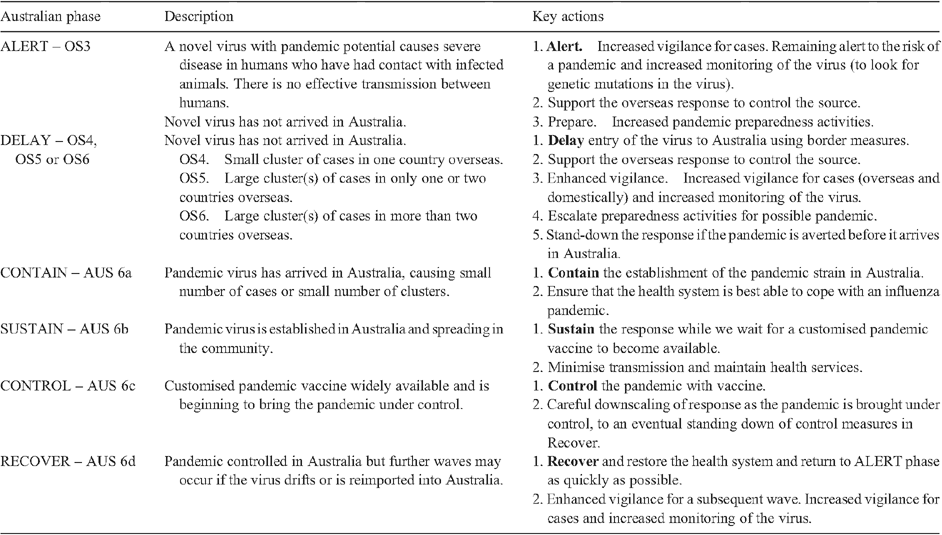
|
The DELAY phase was declared almost immediately in Australia (28 April 2009). In the subsequent weeks, between emergence of the disease in North America and the first case in Australia, the Commonwealth Government exercised its clear responsibilities for quarantine and border measures and prepared for expected use of the National Medicines Stockpile. It also ordered potentially enough vaccine from the pharmaceutical company CSL to vaccinate every Australian, anticipating that this would be ready within 3–6 months. Border control measures were instituted at international airports, including positive pratique of incoming aircraft, health declaration cards for passengers and crew, and health screening by thermal scanners and border nurses. The implementation of such measures was dependent on State health department capacity and workforce, as State employees act as agents for the Commonwealth for human quarantine, with the State providing the nurses to work at the airports, and the Commonwealth undertaking to reimburse this cost.
There was a flurry of policy work over the first few weeks, entailing almost daily teleconferences, which utilised the national committee structure, including key expert groups such as the Communicable Diseases Network Australia (CDNA) and the Public Health Laboratory Network, both subcommittees of AHPC.
How ready was Western Australia?
Western Australia (WA) had developed its own Health Management Plan for Pandemic Influenza, which dove-tailed with the national health plan, and supported ‘WestPlan Human Epidemic’, the whole-of-government State Emergency Management Plan. A State whole-of-government pandemic plan, which outlined broad governance arrangements and strategies to minimise the economic, social and community impacts of an influenza pandemic, had also been developed. The State Health Emergency Operations Centre and WestPlan Human Epidemic (2008) were both activated in late April, and all agencies prepared to activate their pandemic and business continuity plans.
WA also had an established year-round influenza surveillance system involving sentinel general practices and hospital emergency departments, and good laboratory capacity and expertise, with the major public pathology laboratory in WA (PathWest) designated as a WHO National Influenza Centre. Uniquely, WA also had experience since 2008 in running Australia’s only free paediatric influenza vaccine program.
Public education featured in the DELAY and subsequent phases of the pandemic response, with an emphasis on staying at home if ill, respiratory and general hygiene measures (including hand washing and cough etiquette), and social distancing to avoid transmission (within homes, health-care settings and the community).
This early phase saw a large load on diagnostic services, especially the public health laboratories. There was an initial testing peak before the virus becoming established in Australia, which related to public health recommendations for testing aimed at detecting early community cases, but also included the ‘worried well’ presenting for diagnosis. The PathWest laboratory had, in previous seasons, experienced a peak seasonal influenza testing load of fewer than 300 samples per week. In the first few weeks of this pandemic, test demand peaked at 2235 samples per week (Fig. 1), which was complicated by the laboratory’s need to develop, evaluate and validate new tests during this period. Following rationalisation of the testing recommendations in the new PROTECT phase, there was a second more natural peak of testing later in the epidemic, as the virus became established (Fig. 1).
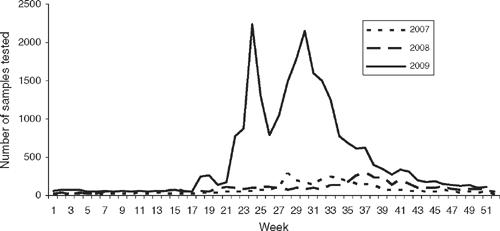
|
Was communication adequate?
The first case occurred in Australia on 7 May. Media (and therefore public) attention is greatest when an item is both new and local, such as happened with the first Australian case. The AHMPPI recognised the importance of public communication as a strategy to both fight the disease and maintain community confidence. The first of four operational objectives of the AHMPPI is to ‘communicate the best available information to decision-makers, health professionals and the public’.4 The other objectives are to minimise spread of the virus, optimise the health system to reduce death and illness, and to work in partnership across all sectors of government.4 These objectives are inter-related: public support is essential for making decisions, for example, about who should have access to antiviral medications or which groups should be prioritised for vaccination.
The NAP also provides a sensible framework for government communication in an evolving situation where there are many uncertainties, principally focussing on ‘telling the public what we know, what we don’t know, what we as government are doing, and what we ask the public to do’.5 Apart from Health Ministers, the Commonwealth Chief Medical Officer was the key national public spokesperson, with national talking points being distributed by the Commonwealth to all States and Territories, for local tailoring. The National Health Emergency Media Response Network, linking media liaison managers across government agencies, helped keep messages consistent. Most states used their Chief Health Officers as their main media spokespersons, allowing for a natural link between decision-making and public communication responsibilities.
In WA, the average number of visitors to the WA Public Health Division website increased from 4000 to 18 700 per month over 2009, with 35 230 visitors accessing the pandemic influenza pages over the period. From April to September, WA Health also fielded almost 900 pH1N1-related media queries.
How flexible was the national response?
One of the first major challenges nationally was dealing with the situation in Victoria, where the disease was spreading in the community, before it became widely established elsewhere in Australia. Australia moved to the CONTAIN phase on 22 May 2009, with an emphasis on testing of symptomatic travellers returning from overseas, isolation and treatment of suspect or proven cases, and tracing of their close contacts, with subsequent home quarantine and provision of antiviral prophylaxis. The implementation of these policies placed considerable workload on State communicable disease control staff.
Given the situation and the 978 cases already diagnosed in that State, Victoria moved from the CONTAIN to a ‘modified SUSTAIN’ phase on 3 June 2009, ahead of the rest of Australia.6 There was considerable debate within expert committees about this dual phasing strategy, and its implications for disease control policy in other states, as the possibility of a difference in disease activity across the country had not been explicitly addressed in the AHMPPI. At this stage, there had been two cases diagnosed in WA.
WA began selective partial or full school closures in early June, with good cooperation from the Department of Education and Training and private schools, after a series of schoolchildren returned from Victoria with influenza and passed it on to classmates. Overall, WA closed five schools in June. Evaluation of the school closure program has shown that it was only partially effective in reducing opportunities for transmission, with many children continuing to mix outside of school, and that it produced substantial adverse effects on families, schools and the workforce.7
NPEC was designed to provide a link between First Ministers’ departments and Health departments. It took advice on the overall impact of the disease in Australia and facilitated decision-making and implementation of the appropriate level of response. For example, selective school closures and a national approach to possible outbreaks on cruise ships were supported, but not cancellation of major events, such as the Victorian State of Origin rugby league game on 3 June 2009. This latter decision may be seen, in retrospect, as pivotal, as it signalled an understanding at the senior government level that the pandemic was not as severe as contemplated in the AHMPPI.
The creation of a new phase, PROTECT
Nationally, the generally mild nature of the disease, and its uneven spread, led to a rethinking of the appropriateness of the AHMPPI phases. A series of discussions, involving the Commonwealth and all States and Territories, ultimately resulted in the creation and implementation of an entirely new phase, PROTECT, on 17 June 2009,8 which allowed for a refocussing of resources, including the use of antiviral drugs only on those most at risk, and some reasonable flexibility in the implementation of State and Territory policies with respect to school closures and other issues. Diagnostic testing was now recommended only for those who were severely ill, who had predisposing medical conditions, or where it would inform clinical management, which lessened the considerable load on the public laboratory system.8 The new PROTECT phase brought the whole country back into alignment with respect to pandemic phase and led to a reformulation of the severity conundrum. ‘Mild in most, severe in some, and moderate overall’ became the accepted phraseology.
Vulnerable groups
The country area in WA is characterised in the main part by small populations distributed across a vast geographical area, some of which are very remote. There are seven country health regions, with each having a comprehensive ‘pandemic’ plan. Regional Public Health Units coordinated the response in remote communities, which included working with local government, Aboriginal Medical Services, the Royal Flying Doctor Service and others to monitor the incidence of influenza-like illness and ensure a timely clinical response where necessary. WA Health had also developed, in conjunction with the Aboriginal community controlled health sector, a response plan for pH1N1 in Aboriginal communities. Antiviral drugs and personal protective equipment (PPE) had been prepositioned in regional centres and Aboriginal community health clinics.
In mid-June, the first death associated with pH1N1 in Australia was reported. An Aboriginal man from a remote Aboriginal community in WA close to the Northern Territory border, died in Adelaide after transfer from Alice Springs Hospital. This first case illustrated the capacity of the virus to spread widely and covertly, the vulnerability of Aboriginal people with their higher than normal levels of underlying chronic disease, and the need to respond across State borders.
There was ongoing public education about those groups most at risk from pandemic influenza: Aboriginal people; those with underlying chronic disease or weakened immunity; the morbidly obese; pregnant women; and young children.
From a State Disaster Management perspective, WA Health took the lead role in support of the State Human Epidemic Controller, the legislated Hazard Management Agency under the Emergency Management Act (2005). Health agencies are more accustomed to playing a support role to other agencies, such as Police, in other disaster responses. The pandemic role involved increased liaison with a range of State Government agencies, Local Government and industry at different phases of the response. For example, WA Health worked closely early on with the Department of Education and Training, as they managed children excluded from schools and school closures, and WA Police, as they grappled with how best to protect their frontline staff. At a later stage, WA Health worked with Department of Premier and Cabinet, providing key advice for NPEC decision-making on phases and vaccination programs, and with Treasury on the costs to the system. Key messages on health measures and workplace issues relating to pandemic influenza were communicated to all State government agencies via an email network of agency CEOs and pandemic contacts, and also to Local Government and industry peak bodies.
How much pressure did the WA health care system absorb?
As community transmission of pH1N1 became established in WA, there was increasing pressure on general practice (Fig. 2) and hospital emergency departments (Fig. 3). The Department of Health established an internet-based ordering system for distribution of PPE and antiviral medications to general practices and in communicating disease-control policy changes to health providers across the State. Provision of PPE to general practice from the National Medicines Stockpile in the DELAY phase was not scheduled in the AHMPPI, but the WA decision to supply PPE to general practice from State resources was an important local measure that ensured that adequate supplies were available and maintained the support of this critical arm of the health sector.9
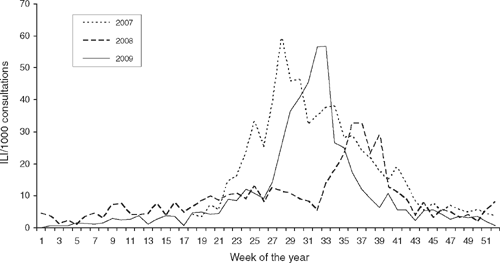
|
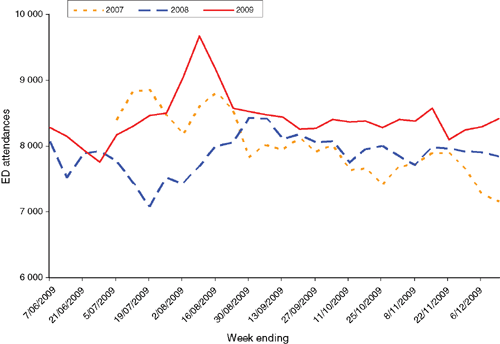
|
General practitioners were faced with a variety of tasks, including patient education, identifying those patients in high-risk groups, providing antiviral treatment where appropriate, and referring sicker patients to hospital, whilst protecting their own staff and other patients in their waiting rooms. The Australian Medical Association, general practice Divisions and professional Colleges played a key role in both encouraging medical staff to continue to provide these services, amidst safety concerns, and providing the scientific and professional support to the rationale behind the new Phase.
Pandemic influenza activity in WA peaked in late July and influenza notifications returned to baseline levels by mid-September. By this time, it had become apparent that the impacts of the pandemic virus, as demonstrated in influenza-like illness (ILI) reporting in both general practice and hospital emergency departments, was in fact broadly similar to levels seen with seasonal influenza in recent years. Other Australian States have reported similar findings.6,10
There was, however, a significantly increased impact of pH1N1 on the critical care segment of the WA health system (Fig. 4) and other State systems.11 During the peak stages of the epidemic, capacity in intensive-care beds was near full, reflecting the fact that the pH1N1 virus had a disproportionate effect (relative to a ‘normal’ influenza season) in causing severe disease in pregnant women and those with underlying medical conditions, as well as in a small proportion of otherwise well people.12
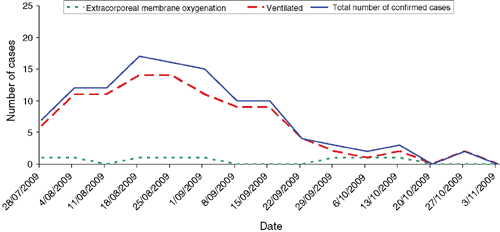
|
Throughout the winter season, States collected a range of surveillance data, including laboratory-confirmed cases of pH1N1, follow-up data on cases and their contacts, ILI presentations to primary care and Emergency Departments, hospitalisation data, mortality data, and border-screening data, and also performed a range of focussed epidemiological studies to better inform local and national responses. In WA, this data collection called for use of both established systems (e.g. ILI sentinel surveillance in general practice) and the rapid development of new or augmented collections, such as the linkage of notification and hospital admission collections to monitor hospital admission rates for pH1N1 in real time. States and Territories closely monitored this information on a daily basis at the peak of the epidemic and fed the data through to the Commonwealth Department of Health and Ageing to form a national picture.
The logistic challenges in supplying both antivirals and personal protective equipment to health care providers were considerable (Figs 5, 6).13 Although the National Medical Stockpile provided the bulk items, the internal distribution of these items fell to the jurisdictions. Although distribution commenced early in the pandemic, the logistic burden was to continue well into the vaccination phase.
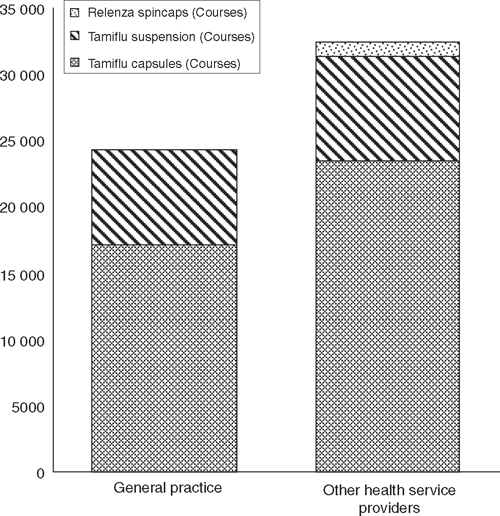
|
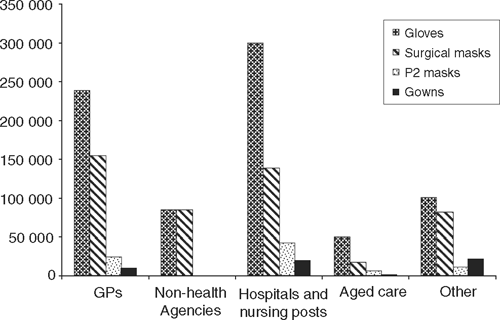
|
The vaccination phase
With successful vaccine development by CSL and with clinical trials in progress in adults and children, planning for a vaccine rollout began. The aim was to provide enough vaccine for every Australian, with the Commonwealth government to purchase and dispatch vaccine to State distribution centres.
Such a simple description, however, belies the complexity of the decision-making involved, both strategically and logistically. Immunisation experts are nearly all employed by State governments (either clinicians or public health personnel), public health laboratories or academia, whereas nationally, immunisation policy and funding for vaccine purchase is the responsibility of the Commonwealth government, who take into account the recommendations from experts and expert committees. Key questions that needed to be resolved included: the safety and efficacy of the vaccine, particularly when it was initially proposed to release the vaccine before registration; to whom it would be given as a priority; and the use of multidose vials.
Therapeutic Goods Administration (TGA) registration became a significant issue. During pandemic planning, it was assumed that Ministerial approval of the vaccine would suffice. However, strong feedback from community and health practitioner groups in all States emphasised that the public (and health community) would not support anything other than a vaccine that was fully certified as safe by the TGA,14 and that providers were concerned about indemnity if the vaccine was not fully registered.
Vaccine distribution and delivery required a massive effort at the State level, with delivery either through general practices or Aboriginal medical services (Federally funded) or through public and community health systems (State funded), of an order of magnitude entirely unprecedented and within a compressed timeframe. In WA, a specific-purpose planning team was assembled for the vaccination effort and worked to meet a range of logistical challenges. Local government support was especially crucial in this phase of the pandemic, with provision of personnel and facilities for special-purpose vaccination clinics, which were conducted in nine metropolitan sites over a three-week period, as well as in selected country sites. Over 1000 WA vaccine providers were trained specifically for the vaccine rollout, given the challenge of using multidose vials. The main burden of vaccine delivery fell to general practice, with strong support, communication and guidance by professional organisations.
TGA approval for use of the adult vaccine was given in September, and the national vaccination strategy was launched in WA by the Federal Minister on 30 September 2009.
Discussion
The 2009 human influenza pandemic comprehensively tested our Federal system’s capacity to manage national emergencies. An overview of the pandemic from an Australian Government perspective has been published,15 and this article aims to provide a more detailed and complementary State perspective.
In WA, as of 5 February 2010, there were 4578 confirmed diagnoses (a considerable underestimate given that not everyone with symptoms was tested after June), 27 deaths in confirmed cases, and 855 hospitalisations, including 82 who were admitted to ICU. An estimated 172 000 people aged 10 years and older, or ~15% of the WA population, had received the pandemic vaccine.16
Mortality data for WA, both in terms of overall deaths and deaths from pneumonia or specific to influenza, supports the proposition that the mortality impact overall of pH1N1 was no greater than that observed in recent years from seasonal influenza, but that the median age of death was much less than in previous seasons. The other impacts described in this article were also greater than in previous seasons.
It is difficult to describe the number of contributors, the scale of the operation, and the myriad of decisions that needed to be made at a State and local level. Contributing to national or local policy, developing operational guidelines, communicating with professionals and the public, tracking patients and tracing contacts, running laboratory tests, creating supply chains for medications and vaccines, collecting and analysing data, and actually caring for the worried well, the mildly symptomatic and the seriously ill, were just some of the high level categories of tasks performed. Table 2 contains some key numbers that give an indication of the impact across the State government sector.

|
The response was organised by bringing together disaster management and communicable disease control personnel within WA Health, and by drawing on clinicians, colleagues in other government departments, and key external stakeholders.
Communication was a tightrope. The public were divided between those who saw the pandemic as a major threat, and those who felt it would not affect them,17 and this division was mirrored by critics and experts, who either felt that government had not done enough, or that it had over-reacted.18 The task was made even harder by the difficulty of describing the severity of this pandemic succinctly and then relating that to an individual’s risk and their need to take action.
Generally, we believe the health and broader systems performed well nationally, both from operational and communications perspectives. Good prior planning certainly helped, and there was flexibility in response. In the introduction to the AHMPPI, it was stated that it was ‘uncertain how severe the next pandemic may be’, and the plan presented a framework that allowed for tailoring of a response.4 The decision to create the PROTECT phase should be seen in that light and not as a reflection of an inadequate plan. Communication between the layers of government, different jurisdictions and via key external bodies, was generally consistent and was certainly helped by the strong communications flavour of the AHMPPI.
Even so, there were some strains in the Federal fabric, most notably over governance, workforce capacity, funding, and with respect to the general practice sector.
The importance of governance arrangements in a Federal system was underlined in the period leading up to the creation of the new PROTECT phase. Victoria was in a different phase to the rest of Australia for 2 weeks and there was contention over the appropriateness of school closure policies and exclusion policies for travellers returning from overseas and Victoria. AHPC worked with NPEC and others to find a way out of this dilemma, with PROTECT being the answer.
There were innumerable other detailed policy discussions at both national and local levels, encompassing a range of strategic and technical matters, that tested the governance arrangements. Expert advice was given freely by a range of groups and individuals, but was not always available in written form for the decision-making committees. There was some doubt at times as to the respective role of expert standing committees, such as the CDNA vis-à-vis expert committees convened specially for the pandemic, such as the Expert Advisory Group on Pandemic Influenza. The role of CDNA, made up of practising disease-control experts from the State health departments, was less prominent compared with its role in responding to SARS in 2004, where it coordinated, in a real sense, the Australian policy response in collaboration with the Commonwealth Department of Health and Ageing. The time seems right to consider the potential role of an independent, authoritative national disease-control agency in Australia, as a clear source of expert advice.19
With respect to workforce, it should be noted that the States are the major employers of skilled public health professionals in the areas of communicable disease control, disaster management and other public health areas, and run most of the public health laboratories. However, within the States, public health workers constitute a very small percentage of all health workers, with public health funding amounting to just over 2% of overall health funding. There are also a small number of learned infectious disease experts employed by the universities, some of whom are influential within WHO and other international bodies.
So, overall, the surge capacity of the public health workforce was stretched by the 2009 pandemic in both metropolitan and regional areas, and needed to draw on the wider health workforce, particularly when it came to deploying staff to international airports for border screening, public and professional education, and planning and delivering the vaccination program.
Hospital and general practitioner workforces were also stretched. The role of general practice in both planning and delivery of the response to a pandemic needs to be strengthened. There are many possible communication channels into individual general practices, either from Commonwealth or State bureaucracies or from general practice Divisions, the AMA or the RACGP, which need to be streamlined in future to avoid duplication, confusion, and overload.
With respect to the important laboratory sector, there is a need to review the collection and referral process in both the private and public sector, to work towards better electronic communications, and to look at increasing diagnostic testing capacity to assist in future pandemic and other emergency responses.
Large sums were made available by the Commonwealth for specific aspects of the pandemic response, including the purchase of antivirals and vaccines, specialised influenza testing equipment in laboratories, and to support the role of general practice. States bore the costs associated with bolstering surge capacity of the existing state health workforce, logistics, enhancing data collection and developing and delivering laboratory tests. The opportunity cost to other programs of the pH1N1 response across the government health sector, particularly in key sectors such as communicable disease control, laboratories, disaster preparedness and infection control, was considerable.
In WA, the overall direct cost to the State Government is conservatively estimated to be in the region of $21.2 million, for the period until the end of January 2010, based on patient treatment, equipment, personnel and logistic costs. However, as with all jurisdictions, these costs did not meet the threshold for Commonwealth Treasury reimbursement, which were based on an expectation that the pandemic should create widespread disruption, similar to the worst of previous pandemics, before additional supplementation was provided.
In summary, relationships were strengthened across and outside Government during the winter of 2009, notwithstanding the tensions identified. Fortunately, the pandemic was not as severe overall as first feared, but it was unpredictable enough to test the health system arrangements thoroughly. Lessons learnt will help shape our response in 2010 and beyond.
Competing interests
Authors declare that no conflicts of interest exist.
Acknowledgements
The authors acknowledge the efforts of staff right across the West Australian health system, who were instrumental in ensuring a comprehensive and successful response to this pandemic. Dr Paul Armstrong and Ms Virginia Ielati provided useful commentary on the manuscript.
References
[1] Echevarría-Zuno S, Mejía-Aranguré JM, Mar-Obeso AJ, Grajales-Muñiz C, Robles-Pérez E, González-León M, Ortega-Alvarez MC, Gonzalez-Bonilla C, Rascón-Pacheco RA, Borja-Aburto VH. Infection and death from influenza A H1N1 virus in Mexico: a retrospective analysis. Lancet 2009; 374 2072–9.| Infection and death from influenza A H1N1 virus in Mexico: a retrospective analysis.Crossref | GoogleScholarGoogle Scholar | 19913290PubMed |
[2] Gostin L. Influenza A (H1N1) (swine origin): perspectives under national and international law. Public Health Bulletin South Australia 2009; 6 4–8.
[3] World Health Organisation (WHO). New influenza A (H1N1) virus: global epidemiological situation, June 2009. Wkly Epidemiol Rec 2009; 84 249–57.
| 19537358PubMed |
[4] Australian Health Management Plan for Pandemic Influenza. Canberra: Australian Government Department of Health and Ageing; 2008.
[5] Council of Australian Governments. Working Group on Australian Influenza Pandemic Prevention and Preparedness. National Action Plan for Human Influenza Pandemic. Canberra: Australian Government Department of Prime Minister and Cabinet; 2009.
[6] Kelly HA. A pandemic response to a disease of predominantly seasonal intensity. Med J Aust 2010; 192 81–3.
| 20078407PubMed |
[7] Effler PV, Carcione D, Giele C, Dowse GK, Goggin L, Mak DB. Household responses to pandemic (H1N1) 2009 – related school closures, Perth, Western Australia. Emerg Infect Dis 2010; 16
| Household responses to pandemic (H1N1) 2009 – related school closures, Perth, Western Australia.Crossref | GoogleScholarGoogle Scholar | 20113554PubMed |
[8] Australian Government Department of Health and Ageing. PROTECT phase. Annex to the Australian Health Management Plan for Pandemic Influenza. Version 3.0. 2009. Available at http://www.healthemergency.gov.au/internet/healthemergency/publishing.nsf/Content/protect-annex [verified 8 February 2010].
[9] Smith EC, Burkle FM, Holman PF, Dunlop JM, Archer FL. Lessons from the front lines: the prehospital experience of the 2009 Novel H1N1 outbreak in Victoria, Australia. Disaster Med Pub Health Prep 2009; 3 S154–9.
| Lessons from the front lines: the prehospital experience of the 2009 Novel H1N1 outbreak in Victoria, Australia.Crossref | GoogleScholarGoogle Scholar |
[10] Chang Y-S, van Hal SJ, Spencer PM, Gosbell IB, Collett PW. Comparison of adult patients hospitalised with pandemic (H1N1) 2009 influenza during the ‘PROTECT’ phase of the pandemic response. Med J Aust 2010; 192 90–3.
| 20078410PubMed |
[11] Lum ME, McMillan AJ, Brook CW, Lester R, Piers LS. Impact of pandemic (H1N1) 2009 influenza on critical care capacity in Victoria. Med J Aust 2009; 191 502–6.
| 19883346PubMed |
[12] The ANZIC Influenza Investigators Critical care services and 2009 H1N1 influenza in Australia and New Zealand. N Engl J Med 2009; 361 1925–34.
| Critical care services and 2009 H1N1 influenza in Australia and New Zealand.Crossref | GoogleScholarGoogle Scholar | 19815860PubMed |
[13] Bradt DA, Epstein J. The rational clinician in a pandemic setting. Med J Aust 2010; 192 87–9.
| 20078409PubMed |
[14] Eastwood K, Durrheim DN, Jones A, Butler M. Acceptance of pandemic (H1N1) 2009 influenza vaccination by the Australian public. Med J Aust 2010; 192 33–6.
| 20047546PubMed |
[15] Bishop JF, Murnane MP, Owen R. Australia’s winter with the 2009 pandemic influenza A (H1N1) virus. N Engl J Med 2009; 361 2591–4.
| Australia’s winter with the 2009 pandemic influenza A (H1N1) virus.Crossref | GoogleScholarGoogle Scholar | 1:CAS:528:DC%2BC3cXjsFSnuw%3D%3D&md5=7a501c9d5f13158f5686a33904b029c7CAS | 19940287PubMed |
[16] Mak DB, Daly AM, Armstrong PK, Effler PV. Pandemic (H1N1) 2009 influenza vaccination coverage in Western Australia. Med J Aust 2010; 193 401–4.
| 20919971PubMed |
[17] Seale H, McLaws M-L, Heywood A, Ward KF, Lowbridge CP, Van D, Gralton J, MacIntyre CR. The community’s attitude towards swine flu and pandemic influenza. Med J Aust 2009; 191 267–9.
| 19740048PubMed |
[18] Sweet M. Pandemic lessons from Australia. BMJ 2009; 339 b3317
| Pandemic lessons from Australia.Crossref | GoogleScholarGoogle Scholar | 19690003PubMed |
[19] Givney RC. A pandemic response to a disease of predominantly seasonal intensity. Med J Aust 2010; 192 722–3.
| 20565355PubMed |
A In this paper, the use of the term ‘States’ shall be taken to mean both ‘States and Territories’.


